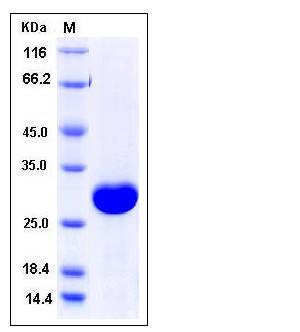Rat UCHL1 / PGP9.5 Protein (His Tag)
UCHL1
- 100ug (NPP3142) Please inquiry
| Catalog Number | P80089-R07E |
|---|---|
| Organism Species | Rat |
| Host | E. coli |
| Synonyms | UCHL1 |
| Molecular Weight | The recombinant rat UCHL1 comprises 233 amino acids and predicts a molecular mass of 26.2 kDa. The apparent molecular mass of the rat UCHL1 is approximately 28 kDa in SDS-PAGE under reducing conditions. |
| predicted N | Met |
| SDS-PAGE |  |
| Purity | > 97 % as determined by SDS-PAGE |
| Protein Construction | A DNA sequence encoding the rat UCHL1 (Q00981) (Glu 2-Ala 223) was fused with a polyhistidine tag at the N-terminus. |
| Bio-activity | Measured by the hydrolysis of UbiquitinAMC. The specific activity is >100 pmoles/min/μg. |
| Research Area | Cancer |Cell cycle |other in cell cycle |Ubiquitin-Proteasome Pathway |Deubiquitinase |
| Formulation | Lyophilized from sterile PBS, pH 7.4 1. Normally 5 % - 8 % trehalose and mannitol are added as protectants before lyophilization. Specific concentrations are included in the hardcopy of COA. |
| Background | Ubiquitin carboxyl-terminal hydrolase isozyme L1, also known as UCH-L1, Ubiquitin thioesterase L1, PGP9.5 and UCHL1, is a deubiqutinating enzyme with important functions in recycling of ubiquitin. Regulated proteolysis by the ubiquitin pathway has been implicated in control of the cell cycle, transcriptional activation, cell fate and growth, and synaptogenesis. The ubiquitin-proteasome system is involved in synaptic plasticity and is proposed to be part of a molecular switch that converts short-term synaptic potentiation to long-term changes in synaptic strength. UCHL1 is found in neuronal cell bodies and processes throughout the neocortex (at protein level). It is expressed in neurons and cells of the diffuse neuroendocrine system and their tumors. UCHL1 is weakly expressed in ovary. UCHL1 is a ubiquitin-protein hydrolase. It is involved both in the processing of ubiquitin precursors and of ubiquitinated proteins. This enzyme is a thiol protease that recognizes and hydrolyzes a peptide bond at the C-terminal glycine of ubiquitin. UCHL1 also binds to free monoubiquitin and may prevent its degradation in lysosomes. The homodimer of UCHL1 may have ATP-independent ubiquitin ligase activity. UCHL1 dysfunction has been associated with neurodegeneration in Parkinson's, Alzheimer's, and Huntington's disease patients. Reduced UCHL1 function may jeopardize the survival of CNS neurons. |
| Reference |
